You’ll find exceptional cellular protection from seven key strawberry anthocyanins: Cyanidin-3-Glucoside activates AMPK for metabolic defense, Pelargonidin-3-Glucoside shields against UVA radiation at 501 nm, Cyanidin-3-Rutinoside enhances ferric reducing capacity, Pelargonidin-3-Rutinoside blocks NF-κB inflammatory pathways, Cyanidin-3-Malonylglucoside crosses the blood-brain barrier for neuroprotection, Pelargonidin-3-Malonylglucoside stimulates antioxidant enzymes, and Anthocyanidin Aglycons provide maximum bioavailability for DNA repair. Each compound targets specific cellular vulnerabilities through distinct protective mechanisms.
Cyanidin-3-Glucoside: The Primary Cellular Defense Anthocyanin

Among strawberries’ powerful compounds, cyanidin-3-glucoside (C3G) stands as the primary anthocyanin responsible for cellular defense mechanisms.
You’ll find this red pigment offers superior bioavailability compared to other anthocyanins, dissolving readily in aqueous solutions for enhanced cellular uptake.
C3G activates your cells’ AMP-activated protein kinase (AMPK), a vital energy regulator that improves metabolism while reducing oxidative stress.
This compound enhances autophagy, effectively delaying cellular aging and senescence.
You’ll benefit from its powerful antioxidant activity as it neutralizes harmful reactive oxygen species and protects your mitochondria from damage.
The compound enters your cells through clathrin- and caveolae-mediated endocytosis, with macropinocytosis contributing to uptake efficiency.
This unique transport system guarantees C3G reaches your cells effectively for peak protection.
C3G demonstrates remarkable anti-inflammatory properties by significantly reducing pro-inflammatory cytokines including TNF-α, IL-1β, IL-6, and IL-8 in your intestinal cells.
Pelargonidin-3-Glucoside: Superior UVA Radiation Protection
While cyanidin-3-glucoside excels at general cellular defense, pelargonidin-3-glucoside (Pg-3-glu) specializes in protecting your cells against UVA radiation damage.
This strawberry anthocyanin exhibits distinct UV-Vis absorption at 501 nm, indicating its unique structural properties for photoprotection.
Pg-3-glu’s antioxidant mechanisms neutralize reactive oxygen species generated by UVA exposure, protecting your DNA, membranes, and mitochondria from oxidative damage.
Pg-3-glu’s targeted antioxidant action shields your cellular DNA, membranes, and mitochondria from destructive UVA-induced reactive oxygen species.
Unlike cyanidin derivatives that primarily target UVB wavelengths, Pg-3-glu provides targeted defense against deeper-penetrating UVA radiation.
Studies demonstrate that Pg-3-glu enhances cellular resilience by upregulating protective enzymes and stabilizing mitochondrial function. This anthocyanin also enhances skin barrier function, which helps maintain optimal cellular hydration and structural integrity.
This anthocyanin’s superior UVA protection stems from its specific antioxidant profile and cellular uptake characteristics, making it particularly effective for preventing UV-induced cellular aging.
Cyanidin-3-Rutinoside: Powerful Oxidative Stress Neutralizer
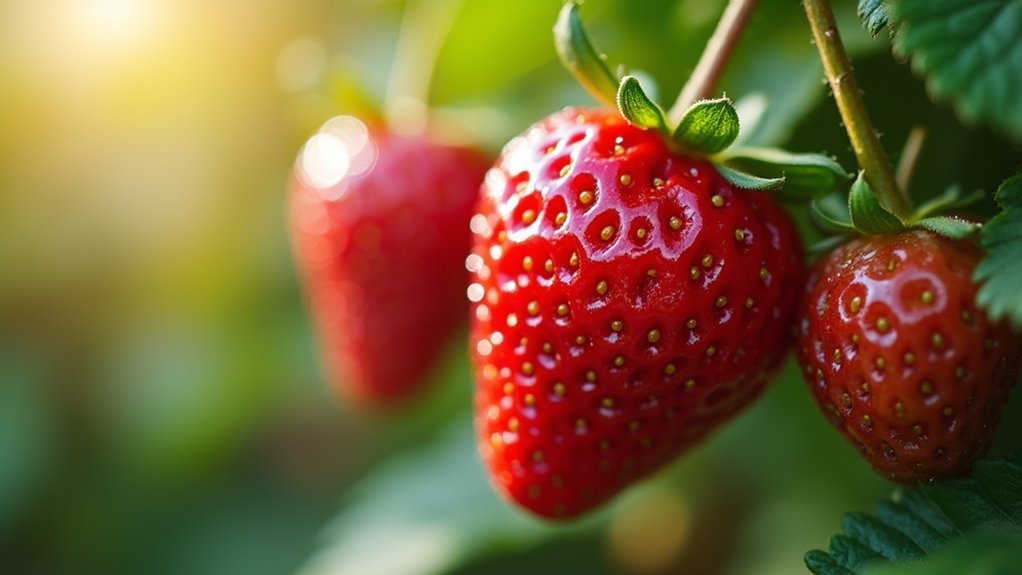
Your cells face constant bombardment from reactive oxygen species that can damage DNA, proteins, and cellular membranes.
Cyanidin-3-rutinoside activates your body’s internal defense systems by triggering protective pathways that neutralize these harmful free radicals before they cause irreversible damage.
This anthocyanin doesn’t just scavenge existing oxidative threats—it actually strengthens your cellular stress response mechanisms to prevent future oxidative damage. Research demonstrates that cyanidin-3-rutinoside significantly increases your cells’ ferric reducing capacity, providing measurable enhancement to your natural antioxidant defenses.
Cellular Defense Mechanisms
When your cells face oxidative assault, cyanidin-3-rutinoside emerges as one of strawberries’ most potent defensive compounds. This remarkable anthocyanin doesn’t just neutralize threats—it actively orchestrates sophisticated cellular defense strategies that protect your healthy cells while targeting damaged ones.
Your body’s cellular protection system gets a significant boost through cyanidin-3-rutinoside’s selective mechanisms:
- Targeted elimination: Induces apoptosis in leukemic cells through controlled peroxide accumulation while sparing normal cells
- Strategic signaling: Activates p38 MAPK and JNK kinases via ROS-dependent pathways for precise cellular responses
- Mitochondrial pathway activation: Triggers Bim-mediated cell death specifically in compromised cells
- Membrane stabilization: Modulates erythrocyte shape and transmembrane potential to maintain cellular integrity
This selective cytotoxicity demonstrates cyanidin-3-rutinoside’s therapeutic potential in cancer treatment applications. Research utilizing both in vitro and in vivo models has validated these remarkable biological properties of anthocyanins at the cellular level.
Stress Response Pathways
Beyond these targeted defensive actions, cyanidin-3-rutinoside orchestrates a sophisticated network of stress response pathways that fundamentally reshape how your cells handle oxidative threats.
This anthocyanin activates p38 MAPK and JNK stress kinases, creating controlled oxidative stress that selectively targets tumor cells while protecting normal cells.
You’ll benefit from its ability to modulate energy metabolism through AMPK activation, enhancing cellular energy sensing and metabolic regulation.
The compound promotes mitochondrial release of apoptogenic factors and upregulates Bim protein, driving tumor cell death through interconnected pathway crosstalk. Through AMPK phosphorylation, this anthocyanin inactivates key coactivators that regulate gluconeogenic pathways, contributing to improved glucose metabolism.
This selective pro-oxidant activity reduces inflammation and improves your cellular microenvironment, demonstrating how cyanidin-3-rutinoside transforms potentially harmful stress into therapeutic advantage.
Pelargonidin-3-Rutinoside: Anti-Inflammatory Cellular Guardian
When inflammation threatens your cells, pelargonidin-3-rutinoside steps in as your body’s defensive specialist, targeting inflammatory pathways with precision.
You’ll find this strawberry anthocyanin doesn’t just fight inflammation—it actively works to maintain your cellular integrity by neutralizing the cascading damage that inflammatory responses can trigger. With its molecular weight of 614.98 g/mol, this compound delivers consistent therapeutic potential in standardized formulations.
Your cells benefit from this compound’s dual approach: it blocks harmful inflammatory signals while simultaneously strengthening cellular defenses to keep your tissues functioning at their best.
Inflammation Response Mechanisms
Although inflammation serves as your body’s natural defense mechanism, chronic inflammatory responses can damage healthy tissues and contribute to various diseases.
Strawberry anthocyanins, particularly pelargonidin-3-O-glucoside (P3G), actively combat this destructive cycle through sophisticated cellular mechanisms. When you consume strawberries, these powerful compounds target multiple inflammatory pathways simultaneously.
Your body’s inflammatory response gets regulated through these key mechanisms:
- NF-κB pathway inhibition – Prevents nuclear translocation that triggers pro-inflammatory molecule activation
- MAPK signaling reduction – Decreases mitogen-activated protein kinase activity and JNK phosphorylation
- Cytokine modulation – Lowers inflammatory markers like IL-1β, TNF-α, and IL-6
- Enzyme suppression – Inhibits COX-2 and iNOS to reduce inflammatory mediator production
Pelargonidin also demonstrates remarkable efficacy in reducing reactive oxygen species production, which directly contributes to cellular damage during inflammatory responses. This multi-targeted approach makes strawberry anthocyanins particularly effective cellular guardians against chronic inflammation.
Cellular Viability Enhancement
While strawberry anthocyanins like pelargonidin-3-O-glucoside demonstrate powerful anti-inflammatory effects, their cousin compound pelargonidin-3-rutinoside takes cellular protection to another level through enhanced viability mechanisms.
You’ll find this rutinoside derivative supports your cells’ survival under both oxidative and inflammatory stress conditions.
Research shows pelargonidin-3-rutinoside combines antioxidant and anti-inflammatory actions for synergistic cellular protection. It enhances your immune cells’ cytokine profiles, increasing protective IL-10 at physiologically relevant doses without impairing bacterial clearance abilities.
Your cells maintain their essential functions while gaining resilience against damage. This compound’s molecular weight of 614.98 g/mol provides optimal bioavailability for cellular uptake and protection.
In laboratory studies, this anthocyanin consistently reduces cellular death in fibroblast and immune cell lines exposed to inflammatory triggers, making it a promising guardian for your cellular health.
Cyanidin-3-Malonylglucoside: Enhanced Neuroprotective Activity

Among strawberry’s anthocyanin compounds, Cyanidin-3-Malonylglucoside stands out for its enhanced neuroprotective capabilities.
This powerful anthocyanin’s malonyl group considerably improves its stability and bioavailability, allowing it to survive longer in your body and potentially increase its effectiveness.
You’ll benefit from its superior ability to cross the blood-brain barrier and deliver targeted antioxidant protection. The compound works by reducing oxidative stress and inflammation in your brain while preventing neurotoxicities from various harmful factors. Its protective effects extend to cholinergic transmission, which is crucial for maintaining cognitive function and memory formation.
Key neuroprotective mechanisms include:
- Oxidative stress reduction – Protects against neuronal cell death and synaptic dysfunction
- Anti-inflammatory action – Reduces inflammation-related brain damage
- Enhanced stability – Malonyl modification increases bioavailability compared to non-malonylated forms
- Gut-brain modulation – Influences microbiota that affects brain health
Pelargonidin-3-Malonylglucoside: Dermal Fibroblast Protector
Your skin’s dermal fibroblasts receive exceptional protection from pelargonidin-3-malonylglucoside, a specialized anthocyanin that maintains cellular health through powerful antioxidant mechanisms. This strawberry compound effectively scavenges reactive oxygen species while reducing lipid peroxidation in cell membranes, preserving essential cellular integrity under stress conditions.
| Protection Mechanism | Cellular Benefit |
|---|---|
| ROS Scavenging | Reduces oxidative damage |
| Enzyme Upregulation | Boosts natural defenses |
| Inflammation Control | Limits tissue damage |
| Collagen Support | Maintains skin structure |
You’ll find this malonylated anthocyanin stimulates your body’s antioxidant defense enzymes, including superoxide dismutase and catalase, while reducing inflammatory markers in fibroblasts. The malonylation enhances cellular uptake and stability, providing longer-lasting protection against photoaging and environmental pollutants that typically accelerate skin aging processes. The compound exhibits optimal stability under specific pH conditions, ensuring consistent protective activity in the skin’s naturally acidic environment.
Anthocyanidin Aglycons: Maximum Bioavailability for Cellular Repair
How can your cells achieve peak healing potential from strawberry anthocyanins? You’ll find the answer in anthocyanidin aglycons – the sugar-free forms that deliver unmatched bioavailability.
When you consume strawberry anthocyanins, your gut enzymes strip away the sugar molecules, creating these potent aglycone compounds that easily penetrate your cellular membranes through passive diffusion. The microbiota transformation of these compounds creates metabolites that work synergistically with the parent anthocyanins to enhance therapeutic effects.
These bioactive molecules transform your cellular defense system:
- Enhanced antioxidant protection – Neutralizes free radicals more effectively than glycosylated forms
- Accelerated DNA repair – Supports your cells’ natural healing mechanisms against oxidative damage
- Improved redox balance – Maintains ideal cellular environment for repair processes
- Increased protein binding – Extends bioactivity duration within your system
You’ll maximize absorption by supporting your gut microflora health, which efficiently converts anthocyanins into these therapeutic aglycons.
Frequently Asked Questions
How Much Strawberry Anthocyanin Should I Consume Daily for Optimal Cellular Protection?
You should consume 250-500g of fresh strawberries daily, providing approximately 9.57mg of anthocyanins from 300g. Alternatively, you can take 10-60g of freeze-dried strawberry powder for ideal cellular protection.
Can Strawberry Anthocyanins Interact With Medications or Cause Adverse Effects?
Yes, strawberry anthocyanins can interact with medications by affecting drug-metabolizing enzymes and increasing absorption of certain drugs like etoposide and paclitaxel. You should consult your healthcare provider before consuming large quantities.
Are Fresh Strawberries or Supplements Better for Obtaining Protective Anthocyanins?
You’ll get broader nutrients from fresh strawberries, but supplements offer standardized dosing and better absorption. Fresh strawberries provide vitamin C and fiber alongside anthocyanins, while supplements deliver targeted, consistent amounts for cellular protection.
How Long Does It Take to See Cellular Protection Benefits From Anthocyanins?
You’ll notice immediate antioxidant effects within hours, but meaningful cellular protection develops over 2-4 weeks of consistent intake. Long-term benefits like inflammation reduction require months of regular anthocyanin consumption.
Do Cooking or Processing Strawberries Reduce Their Anthocyanin Protective Properties?
Yes, cooking and processing strawberries can reduce their anthocyanin protective properties. Heat degrades these compounds, and water-based cooking methods cause leaching. You’ll retain more benefits using gentle techniques like steaming instead of boiling.
In Summary
You’ve discovered seven powerful strawberry anthocyanins that’ll fortify your cells against daily damage. From cyanidin-3-glucoside’s primary defense to pelargonidin compounds’ specialized protection, these natural antioxidants work synergistically to shield you from UV radiation, oxidative stress, and inflammation. Whether you’re protecting your brain cells or supporting skin health, incorporating strawberries rich in these specific anthocyanins into your diet provides targeted cellular armor you can’t afford to ignore.

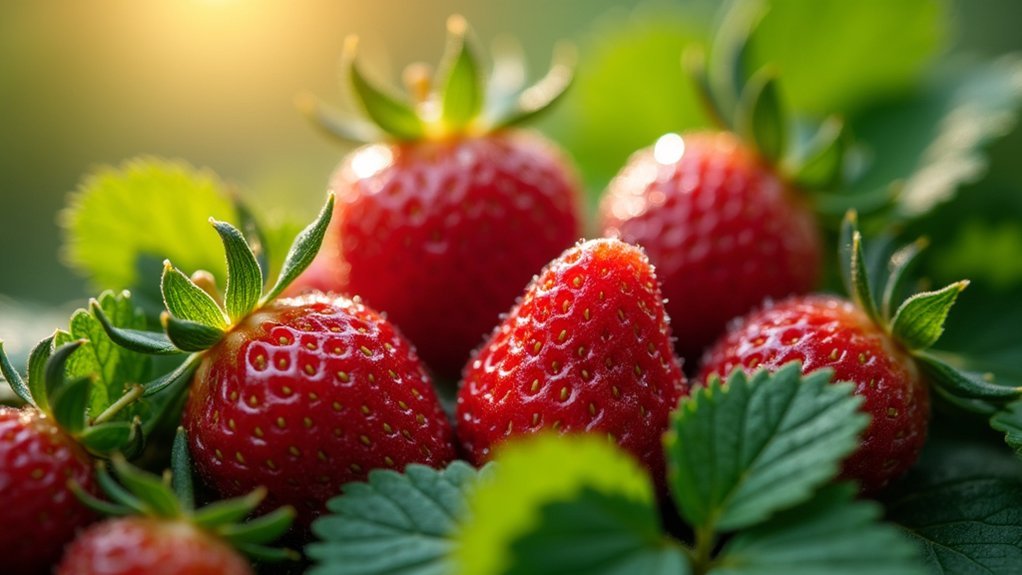
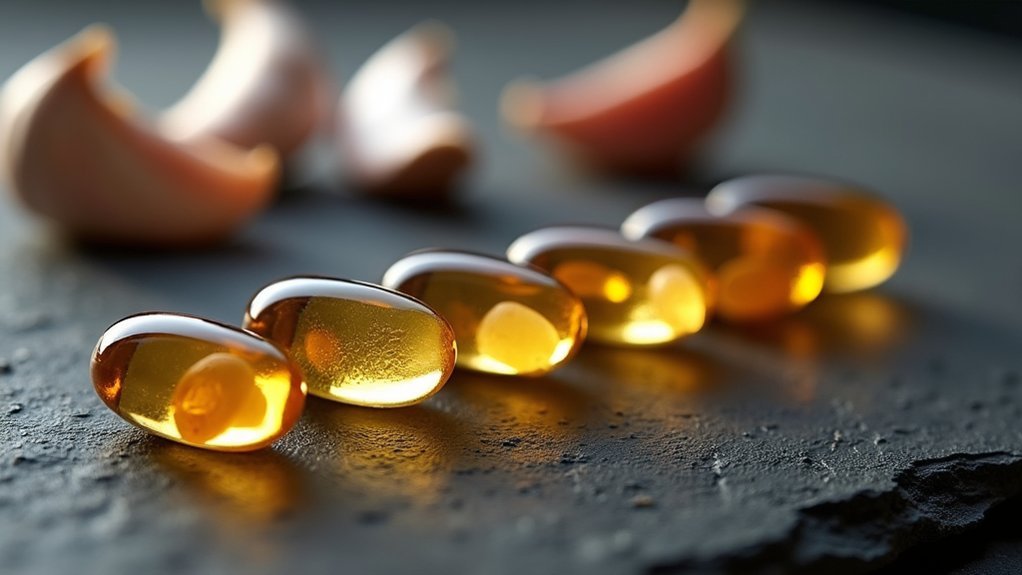
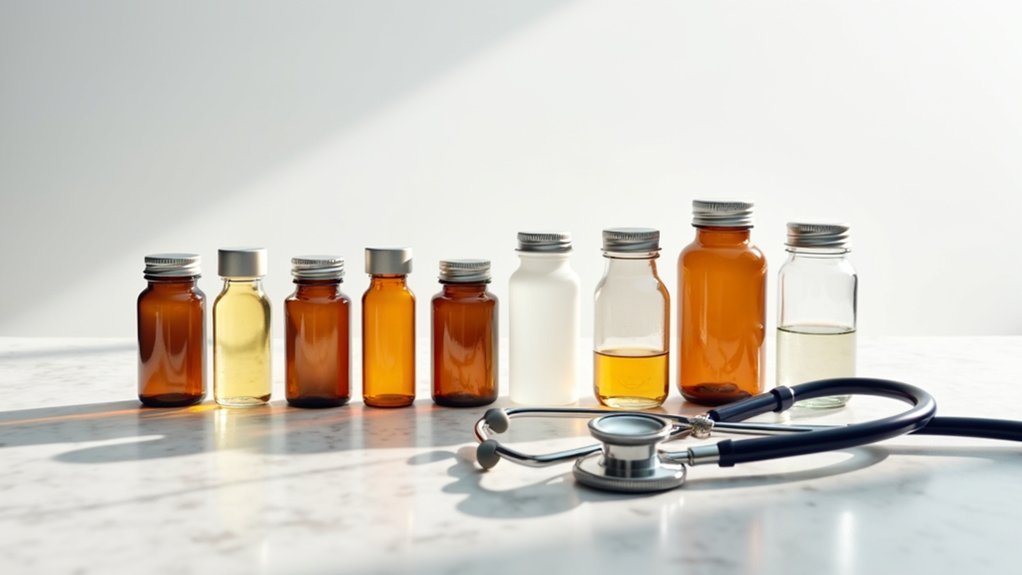
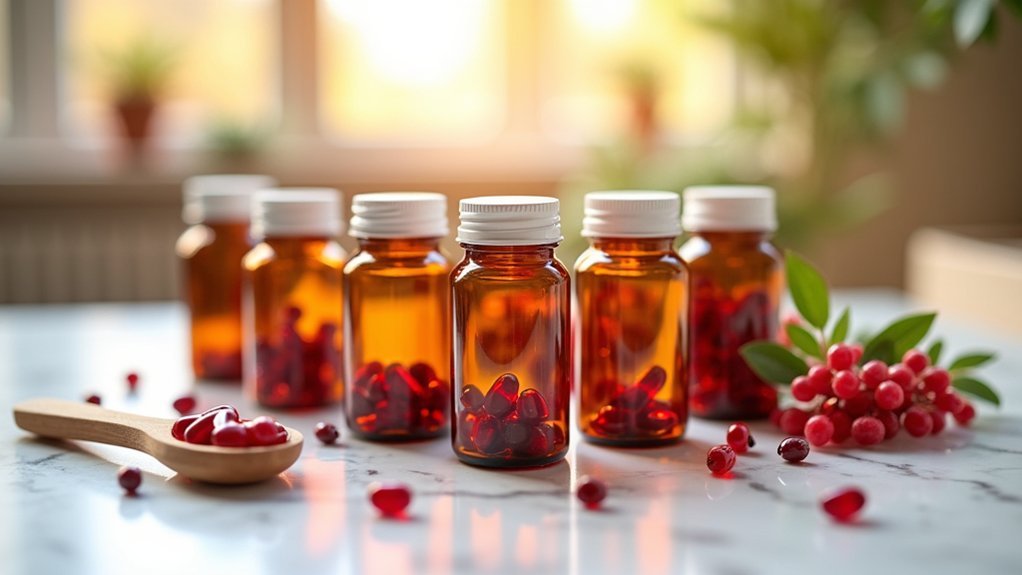
Leave a Reply